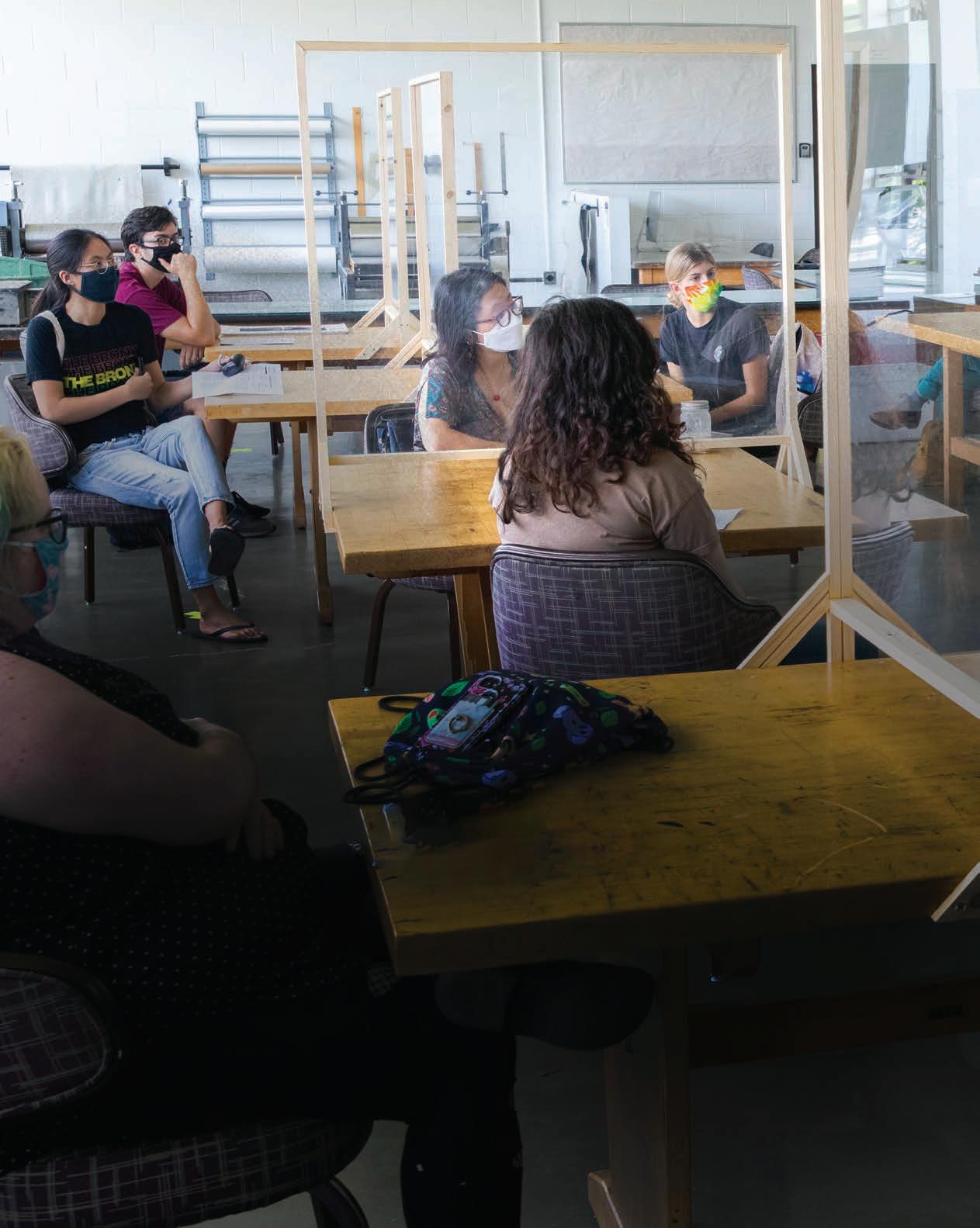
7 minute read
Restarting Binghamton
Plan helped safeguard campus community while enabling University to meet academic mission
By Eric Coker and Katie Ellis
Colin Lyons, an assistant professor in the Department of Art and Design, teaches his Printmaking class in the Fine Arts Building as students sit 6 feet apart with masks on.

Ideas and feedback from hundreds of faculty, staff, students and administrators. Guidance and support from New York state government and public health officials. Input and assistance from Broome County, the City of Binghamton and municipalities.
It took Binghamton University more than three months of teamwork to develop and implement its Restarting Binghamton plan. The COVID-19 response plan, approved by the State University of New York on July 1, enabled students to receive onsite instruction and residential experiences on a campus that is safe for living and learning.
“More complex than the initial shift to remote learning in March, the overriding concern in developing the plan has been to protect the health and safety of our students, faculty and staff,” President Harvey Stenger said in a letter to the campus community. “The result is a detailed plan that lays out the process by which the University could, to the fullest extent possible, return to its educational, research and outreach missions.”
The principles of the plan are: • Protect the health and safety of everyone associated with the University: students, faculty, staff and community members. • Maximize the value of education by maintaining access for all students admitted to the University regardless of economic means, and maximize the success of all students to enhance their lives and futures. • Sustain the research activities of the University to the greatest extent possible. • Contribute to the economic recovery of the region.
In August, nearly five months to the day from when classes shifted online and most students were sent home for the spring semester, Binghamton University brought students and faculty back to campus.
THE CLASSES
The Restarting Binghamton plan provided students with more options for how they attend class.
“Our faculty did an exceptional job switching so quickly from in-person to online education this past semester,” says Donald Nieman, executive vice president for academic affairs and provost. “We’re working to give our faculty the tools they need to engage our students whether they are in a socially distanced classroom setting or participating in classes from a remote location. One of the formats we are instituting is called Bingflex, which provides students with options for attending class.”
Bingflex courses combine both in-person instruction with real-time (synchronous) videoconferencing, so students can interact with the instructor and other students whether they attend the class in person or participate remotely. Students in Bingflex courses will determine which mode of instruction they will participate in for the entire semester. Some will prefer in-person; others will select synchronous online.
For students attending in person, there will never be a situation where there are more students
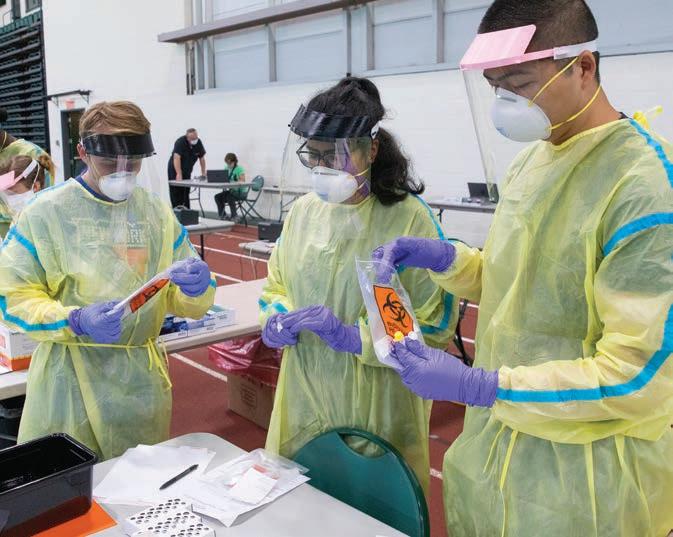
School of Pharmacy and Pharmaceutical Sciences student Brian Kam, right, tests COVID-19 samples at the Events Center during Move-In Week. With Kam are Mehnaz Alam and Timothy Stock.

Physical Facilities cleaner Misty Lou Finch readies Broome Hall at Newing College for students returning for the fall semester.
than can be acceptable under social distancing guidelines. Most large lecture classes remain online-only.
“The whole part of Bingflex is that it is flexible,” says Andrea MacArgel, director of instructional design services for the University. “If in the middle of the semester a student gets sick, that student can go online. Everything is flexible in that sense.”
The academic calendar was also tweaked, so students will not return to campus after the Thanksgiving break. Instead, classes will be held exclusively online from Nov. 30 to Dec. 7, with an assessment period of Dec. 8-11.
THE COVID-19 TESTING
The University welcomed new students to campus with a week-long move-in period that required initial COVID-19 testing in the Events Center. More than 6,200 incoming students were tested between Aug. 19 and Aug. 25. Only 28 tested positive. Of those, the majority returned home to isolate, with four isolating on campus in a dedicated area and one isolating off campus.
David Hubeny, executive director of the University’s Office of Emergency Management, credits his team and campus volunteers for the testing success.
“Although nothing about a testing process as complex as this was easy, it was the volunteers and staff that made everything as easy as it possibly could have been,” he says. “They worked tirelessly to provide the highest level of professionalism and customer service that they possibly could. The volunteers and staff required very little oversight from managers because they were self-motivated and highly focused throughout each of the seven testing days.”
Surveillance testing then continued through the fall semester. The testing looks at samples of the campus population, rather than testing everyone, to try to identify problem areas or potential hotspots for spreading the virus. Students, faculty or staff members selected for testing are being
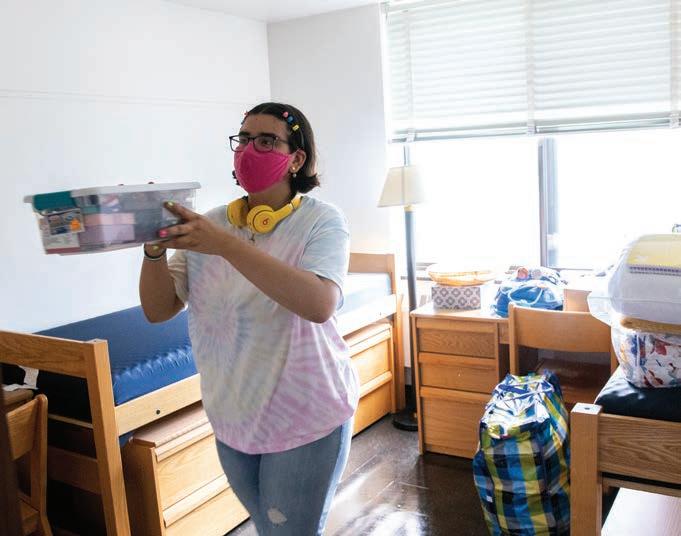
Alexandra Tabora, of Yonkers, unpacks her belongings in her Roosevelt Hall room at Hinman College.
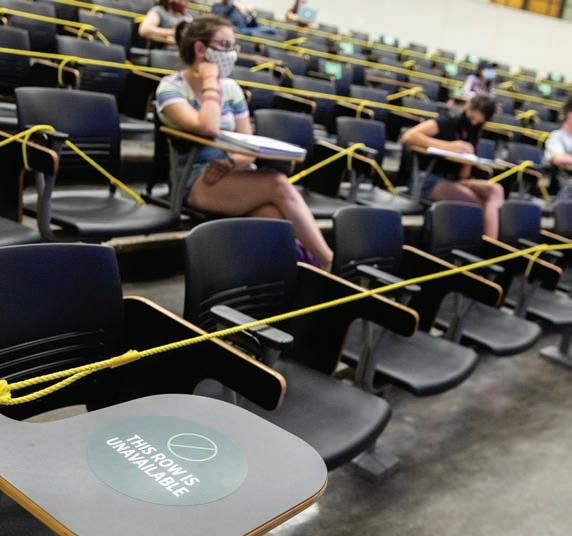
Masked students sit 6 feet apart during a Native American Culture and History class taught by Distinguished Professor of Anthropology Randall McGuire.
Student Jacinta Addo-Badu sanitizes bowling balls while working at the bowling alley in the Undergrounds at the University Union.
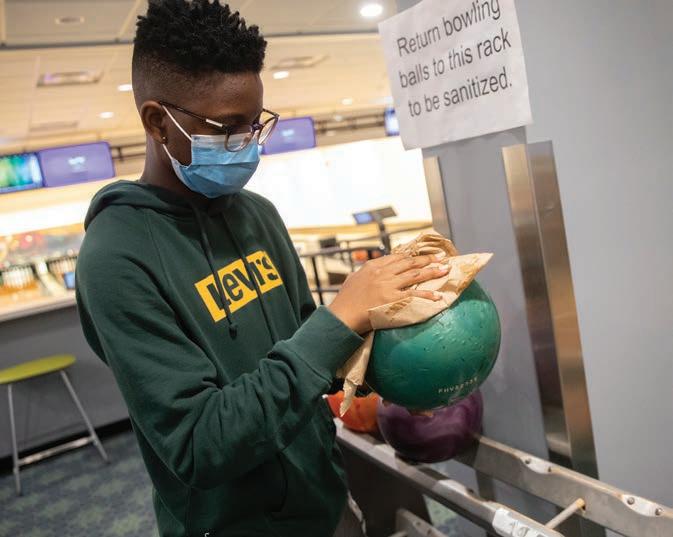
First-year students line up for COVID-19 testing at the Events Center during the first day of Move-In Week in August. Testing instructions can be seen on the scoreboard.

notified 48 hours in advance and asked to register for a two-hour time slot that is convenient for them at Old Union Hall.
Updated test results can be found at the University’s COVID-19 dashboard at www. binghamton.edu/restarting-binghamton/covid19-dashboard.html.
OTHER MEASURES
• Campus-community members must wear face coverings or masks that cover the nose and mouth at all times while in a Binghamton University or University-affiliated space. This includes all University buildings, grounds, classrooms, shared lab areas, conference rooms, restrooms, elevators, parking structures, etc. It doesn’t include instances when someone is alone in a private room, office or vehicle; cubicle space when appropriate social distancing can be maintained; in an isolated area with no other people in proximity; or when exercising outside when appropriate social distancing can be maintained. Binghamton University Dining Services changes include limited seating, serving all meals in carryout containers, vegan options, prepackaging meals to speed delivery and minimize wait times in lines, adding touchless payment processes and increasing sanitation in all facilities. The campus is not hosting in-person events that are open to the public during the fall semester. Co-curricular gatherings and meetings of student organizations occur only with appropriate social distancing (at least 6 feet of space between people) and will require participants to wear masks (unless outside and appropriately physically distanced). There will be no plays, concerts, musical performances or film screenings with in-person audiences. In July, the America East Conference postponed fall athletic competition through the end of the semester. Affected sports at Binghamton University are: men’s and women’s soccer; men’s and women’s cross country; volleyball; and golf.
Members of the Binghamton Ballroom Dance Association hold a (socially distanced) workshop near the Pegasus statue at Harpur Quad.
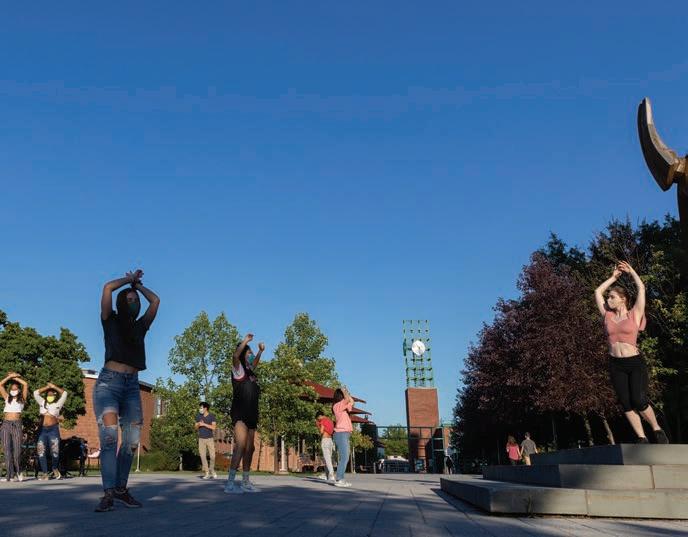
First-year student Alexa Gutterson takes part in lecturer Steve Murphy’s General Chemistry class in the University Union on the first day of fall classes.

FIGHTING THE PANDEMIC
A list of initiatives that have taken place at Binghamton University since the end of the spring semester:
Continually sourced and distributed personal protective equipment (PPE) so that faculty, staff and students have all the safety supplies they need. Distributed personal hand sanitizer, face masks and microfiber cloths to all faculty, staff and students. Installed hand-sanitizing stations in all buildings on campus. Installed paper towel dispensers in all bathrooms on campus. Lowered the campus density in offices, public spaces and classrooms and also removed furniture across campus to reduce the ability of people to congregate in groups. Improved air circulation in all of the buildings and upgraded filters throughout campus. Installed Wi-Fi coverage in Lot M and Lot G1. Installed QR codes in various rooms on campus so students can sign in and out to assist with potential contact tracing. Created a daily symptomtracking system to be able to identify potential cases early and provide contact information for symptomatic faculty, staff and students. Collaborated with Broome County to increase capabilities to contacttrace. Established a system for testing all on-campus students as they arrive. Partnered with the City of Binghamton on a new ordinance to reduce large gatherings. Hung thousands of signs and directional aids all over campus. Simulated campus pedestrian traffic virtually. Optimized the ability to work and teach with minimal contact. Communicated regularly with the entire campus community using the Restarting Binghamton website, including frequently asked questions, as well as through direct messaging to students, faculty and staff.





